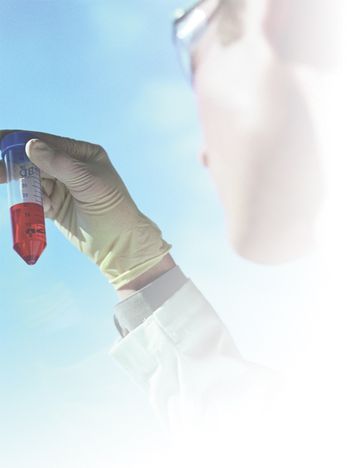
With a bright new future following restructuring, Dublin-based Elan sees former executives establish exciting new businesses in Ireland, while it continues its own strong R&D program.

With a bright new future following restructuring, Dublin-based Elan sees former executives establish exciting new businesses in Ireland, while it continues its own strong R&D program.

The EU Framework Program has operated for the last twenty years, dedicating large sums of funding over five-year periods, all the time aiming to achieve scientific excellence, improved competitiveness, and innovation through promoting increased cooperation between researchers and industry across Europe.

Ireland's Forward-Thinking Business Support Strategy Encourages Research Funding and Fast-Track Company Growth

Venture capital activity in Ireland grew 25.7% in the first half of 2005 compared with the same period in 2004. New life-sciences venture capital funds have been established and existing firms have ramped up their activity in the sector.

The Irish Minister for Enterprise, Trade, and Employment supports and encourages biotech research and development.

The creation, dissemination, and exploitation of knowledge are the keys to unlocking the potential of Ireland's economy.

The cell density achieved in a CELLine bioreactor is typically 1 to 2 orders of magnitude higher than in a conventional culture vessel

Doctors can charge up to $500 per hour to discuss the pros and cons of clinical drug trials.

According to a 2005 study by the American Academy of Neurology, donepezil may improve the memory of Alzheimers patients and those suffering with multiple sclerosis.

Operating costs are the white-hot issue in the boardrooms of our life sciences clients and they tend to rule the site selection process. A soft economy, worldwide trade competition, drug cost containment pressures from the US government, and a lean and mean message sent by the venture capital community mean that quantitative factors that focus on the cost of doing business are trumping qualitative lifestyle factors, especially when evaluating sites for a new biopharmaceutical facility.

The ripple effects of 9/11 are still being felt, creating changes among individuals, businesses, and government organizations. The biotech community is no different; companies are taking a new look at the way they do business and shifting their focuses in response to new opportunities presented by federal preparedness programs. In 2004, President Bush signed "Project BioShield," a bill that made $5.6 billion in federal funds available over a 10-year period to develop countermeasures against chemical, biological, radiological, or nuclear attack. An additional $2.5 billion was added to the initiative in 2005. Numerous grants and contracts have already been awarded to companies developing innovative prophylactic measures, treatments, and diagnostic tools to be used in the event of a biological attack.

...each day a product is delayed is estimated to cost upwards of $1 million to $100 million.

IT, payroll, manufacturing, and clinical-trial data management are key areas for growth in biopharm outsourcing efforts.

Formal process and operation improvement activities are being employed in almost every biopharmaceutical manufacturing company, according to a recent survey conducted by Tefen Ltd and Millipore Corporation. The industry-wide survey was conducted to assess current biopharmaceutical operations excellence (OpEx) trends and needs, as well as OpEx perceptions and expectations related to industry suppliers.

As a company that performs site selection for biopharmaceutical companies worldwide, Fluor Global Location Strategies has witnessed one country truly distinguishing itself from the competition as a worldwide leader in the industry: the United Kingdom. The global competition for biotech investments has been at a fever pitch over the past few years, with varied results.

...biopharmaceutical companies still face rampant piracy and counterfeiting of patented products.

Daunting but common challenges currently face many biotech, pharmaceutical, and device firms. These companies are encountering a restless public, worried investors, and a skeptical, publicity-hungry Congress that are all concerned about product safety and the reliability of regulators' scrutiny.

Part of the problem with cancer drugs as investment picks is that investors don't trust the underlying studies that seem to prop up vaccine maker stocks.

Historically, the big pharmaceutical companies (Big Pharma) have sought to feed their marketing machines by manufacturing blockbuster drugs—chemical-based, one-type-fits-all products that treat chronic conditions such as heart disease or arthritis. This approach has yielded recurring revenue streams from large patient populations. In contrast, biotechnology companies typically have created protein-based drugs,or biologics, to treat acute or niche conditions and diseases. With few exceptions (such as the biotech giant Amgen), biotech companies have foregone doing the marketing and sales of their drugs themselves, and have, instead, relied on others to perform their marketing and sales functions.

The Interface of America's Antitrust and Intellectual Property Laws

Patents are litigated in the biopharmaceutical industry perhaps more often than any other form of IP

Trademark protection in the US is based on a dual system of federal and state laws.

Biopharmaceutical companies need to consider intellectual property issues early on, even at the start-up stage.

Your research and development team has just shouted "Eureka!" after long and expensive years of research, exclaiming they have developed a next-generation pain reliever. What do you do next? This article explores and suggests your next steps and identifies pertinent questions to ask a patent attorney. The focus is on intellectual property; this article does not address the myriad regulatory issues that must be resolved.

It's summer and the living is easy if you don't mind heat, insects, and thunderstorms. The biopharm indexes are listless, because August and September are notorious for inactivity in the various life sciences stock market indexes. Earnings announcements taper off and life sciences companies keep their gunpowder dry by holding off new announcements until after Labor Day. As of mid-July, the American Biotech Index (Symbol: BTK) has leveled off at the tail end of a year of unbridled growth. If history is any indication, the autumn months will see another rise from the 550 or so levels we're now seeing in the BTK.